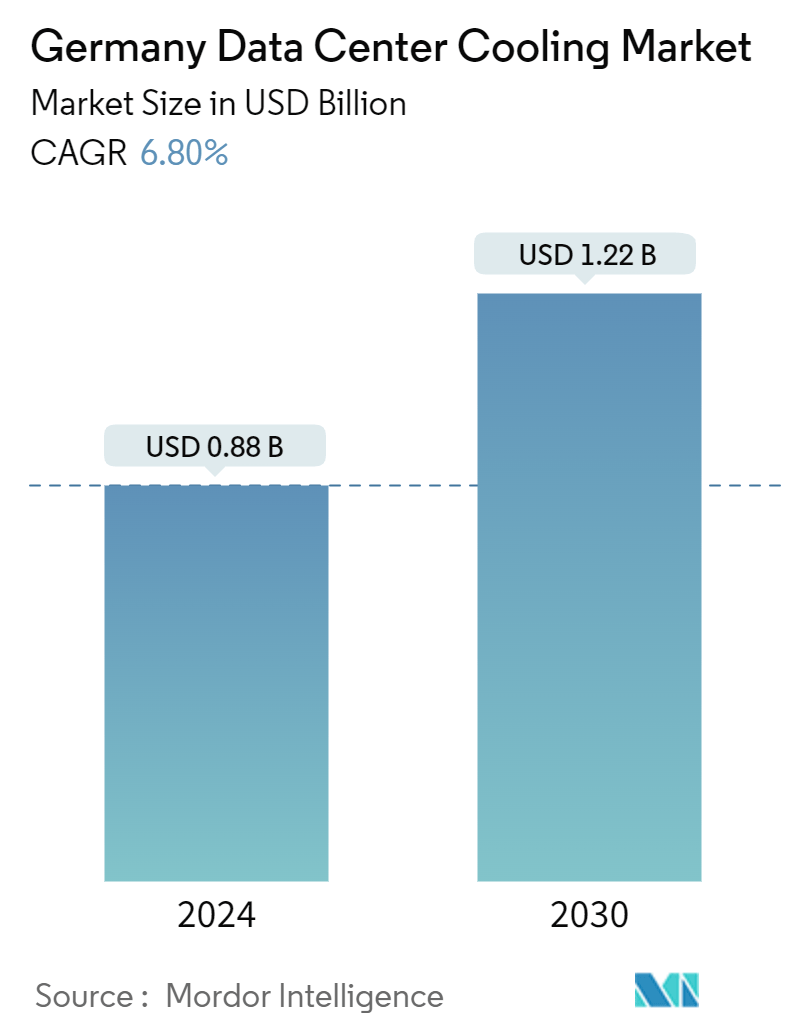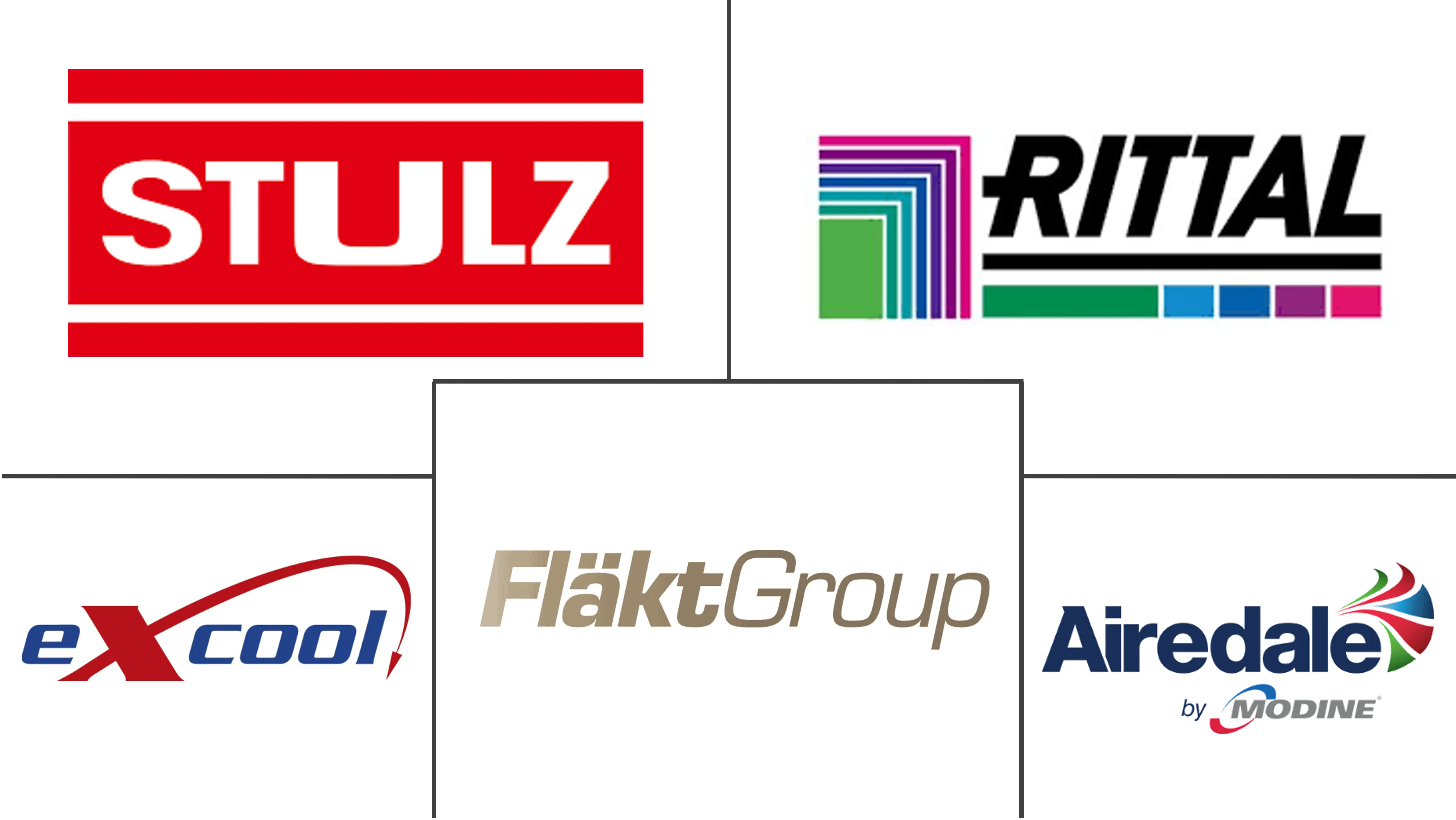Market Size of Germany Data Center Cooling Industry

| Study Period | 2019 - 2030 |
| Base Year For Estimation | 2023 |
| Market Size (2024) | USD 0.88 Billion |
| Market Size (2029) | USD 1.22 Billion |
| CAGR (2024 - 2030) | 6.80 % |
| Market Concentration | High |
Major Players
*Disclaimer: Major Players sorted in no particular order |
Germany Data Center Cooling Market Analysis
The Germany Data Center Cooling Market size is estimated at USD 0.88 billion in 2024, and is expected to reach USD 1.22 billion by 2029, growing at a CAGR of 6.80% during the forecast period (2024-2029).
The German government passed a draft of the Energy Efficiency Act in April 2023, which is now being debated in parliament. Section four of the draft is dedicated in detail to new requirements for the energy efficiency of data centers. According to the draft, newly built data centers would be obliged to comply with energy efficiency standards, ensure a minimum temperature for air cooling, and use the waste heat they generate.
- The upcoming IT load capacity of the German data center market is expected to reach 2.4K MW by 2029. The country's construction of raised floor area is expected to increase to 11.8 million sq. ft by 2029.
- The country's total number of racks to be installed is expected to reach 589K units by 2029. Frankfurt is expected to house the maximum number of racks by 2029. There are close to 7 submarine cable systems connecting Germany, and many are under construction.
- In terms of development, in July 2023, Prysmian Group inked a service level agreement with the German-Dutch transmission system operator TenneT to provide nearshore and offshore cable inspection, maintenance, and repair services for TenneT's HVDC and HVAC submarine power cables in the North Sea. The agreement will be fulfilled in partnership with N-Sea.
Germany Data Center Cooling Industry Segmentation
Data center cooling is a set of techniques and technologies to maintain optimal operating temperatures in data center environments. Data center cooling is critical as data center facilities house many computer servers and network equipment that generate heat during operation. Efficient cooling systems are used to dissipate this heat and prevent equipment from overheating, ensuring continued reliable operation of the data center. Various methods, such as air conditioning, liquid cooling, and hot/cold aisle containment, are commonly used to control temperature and humidity in data centers.
The Germany data center cooling market is segmented by cooling technology type (air-based cooling, liquid-based cooling, and evaporative cooling) and end-user (IT & telecommunication, BFSI, government, and media & entertainment, and other end-users).
The market sizes and forecasts are provided in terms of value (USD) for all the above segments.
| Cooling Technology | |
| Air-based Cooling | |
| Liquid-based Cooling | |
| Evaporative Cooling |
| End-User | |
| IT & Telecommunication | |
| BFSI | |
| Government | |
| Media & Entertainment | |
| Other End-Users |
Germany Data Center Cooling Market Size Summary
The German data center cooling market is experiencing significant growth, driven by the increasing demand for efficient cooling solutions to support the rising IT load and network traffic. The government's focus on energy efficiency, as evidenced by the draft Energy Efficiency Act, mandates new data centers to adhere to strict energy standards, including temperature controls and waste heat utilization. This regulatory environment, coupled with the expansion of fiber-optic and 5G networks, is propelling the construction of new data centers and the adoption of advanced cooling technologies. Liquid cooling systems are becoming essential, particularly in facilities with high-density racks, to maintain optimal performance and manage the heat generated by modern IT equipment. The integration of cloud infrastructure further amplifies the demand for data centers, thereby increasing the need for effective cooling solutions.
The market is characterized by a degree of consolidation among key players, such as FlaktGroup Holding GmbH, Excool Ltd., and Airedale International Air Conditioning Ltd., who are leveraging strategic collaborations to enhance their market presence and profitability. Innovations like Stulz's CyberCoolFree Cooling Booster and Rittal's Blue e+ S range exemplify the industry's commitment to sustainable and efficient cooling solutions. These advancements not only improve operational reliability and extend equipment lifespan but also contribute to environmental sustainability by reducing CO2 emissions. As the market continues to evolve, these leading companies are poised to maintain their competitive edge by offering cutting-edge technologies that meet the growing demands of the data center cooling sector in Germany.
Germany Data Center Cooling Market Size - Table of Contents
-
1. Market Dynamics
-
1.1 Market Overview
-
1.2 Market Drivers
-
1.2.1 Development of Cloud Infrastructure
-
1.2.2 Emergence of Renewable and Green Data Centers
-
-
1.3 Market Restraints
-
1.3.1 Adaptability Requirements and Power Outages
-
-
1.4 Value Chain / Supply Chain Analysis
-
1.5 Industry Attractiveness - Porter's Five Forces Analysis
-
1.5.1 Threat of New Entrants
-
1.5.2 Bargaining Power of Buyers/Consumers
-
1.5.3 Bargaining Power of Suppliers
-
1.5.4 Threat of Substitute Products
-
1.5.5 Intensity of Competitive Rivalry
-
-
1.6 Assessment of COVID-19 Impact
-
-
2. MARKET SEGMENTATION
-
2.1 Cooling Technology
-
2.1.1 Air-based Cooling
-
2.1.2 Liquid-based Cooling
-
2.1.3 Evaporative Cooling
-
-
2.2 End-User
-
2.2.1 IT & Telecommunication
-
2.2.2 BFSI
-
2.2.3 Government
-
2.2.4 Media & Entertainment
-
2.2.5 Other End-Users
-
-
Germany Data Center Cooling Market Size FAQs
How big is the Germany Data Center Cooling Market?
The Germany Data Center Cooling Market size is expected to reach USD 0.88 billion in 2024 and grow at a CAGR of 6.80% to reach USD 1.22 billion by 2029.
What is the current Germany Data Center Cooling Market size?
In 2024, the Germany Data Center Cooling Market size is expected to reach USD 0.88 billion.

